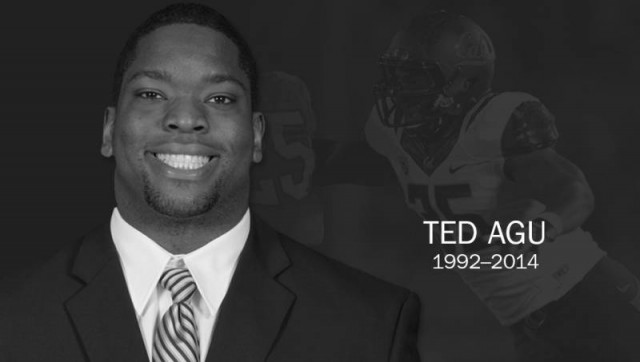Dr. Thomas Beaver, Alameda County’s former chief forensic pathologist, performed the initial autopsy on Agu shortly after he died on Feb. 7. He says he observed that Agu’s heart was somewhat enlarged.
“It’s not what I would call a severe case, it’s not incompatible with life,” Beaver says. He adds that the discovery led him to focus on hypertrophic cardiomyopathy, a condition that leads to abnormal thickening of the heart muscle, as a possible cause of death.
Beaver says he was told Agu suddenly collapsed during a conditioning drill and couldn’t be revived, a sequence of events that suggested a sudden cardiac event.
A Surprise Discovery
Weeks later, Beaver got slides of Agu’s heart tissue and set out to confirm his theory. It was only then that he made a surprising discovery: abnormal, “sickled” red blood cells.
“I didn’t discover the sickle cell until I was looking at the tissues under the microscope, and I was shocked to see it,” he says.
Beaver says that none of the medical records he saw suggested Agu had sickle cell trait.
“So, I mean I didn’t expect that at all,” says Beaver. He adds that after discovering the condition, he asked Agu’s family for medical records to learn more about the player’s sickle cell history, but he never received any.
Coroner’s records show that a nurse at Alta Bates who reported Agu’s death mentioned a “history of sickle cell anemia.” Beaver said that statement was nonspecific and never substantiated. Beaver says “history” could have referred to Agu or his family, and sickle cell “anemia” or “disease” is different from sickle cell trait.
The apparent absence of documentation of Agu’s sickle cell status is remarkable in light of an NCAA policy that took effect in 2010 that acknowledges sickle cell trait’s potential danger and requires athletes to undergo sickle cell tests or submit the results of prior tests. UC Berkeley says it complies with the policy.
In the end, Beaver’s synopsis of Agu’s cause of death stated the player died of hypertrophic cardiomyopathy “based on the information available to me at this time.”
“If you read my comment carefully,” he says, “it’s very hesitant on the diagnosis and it leaves a lot of room for the sickle cell to become the diagnosis, given history or more information or whatever, so I agonized over each of those words.”
Lawyers for Agu’s family said during a press conference earlier this month that the player, a defensive star at Bakersfield’s Frontier High School, had tested positive for sickle cell trait in 2010, before he came to Cal. They say the school later confirmed that finding. The family’s suit says Agu’s status meant coaches and trainers should have been monitoring him more carefully during the tough Feb. 7 workout session and should have responded much more promptly when they realized he was in distress.
“He didn’t die within seconds from the onset of his symptoms,” said attorney Steven Yerrid. “A sickling athlete has very, very definitive symptomatology, it’s very well known. The problem is you have to have people watching, and you have to have people intervening, and looking out for the welfare of the student athlete.”
The lawsuit also alleges that Cal was negligent in hiring and supervising one of the trainers overseeing the workout that preceded Agu’s death. That’s because the trainer was also present during what the lawsuit calls a “remarkably similar” 2008 incident at the University of Central Florida, when another player with sickle cell trait died after a workout.
In a statement responding to the lawsuit, UC Berkeley reiterated that it follows “all recommended protocols, including those outlined by the NCAA, for all student-athletes with identified medical conditions” — including the requirement for sickle cell testing. The statement also said that the university provided all “relevant medical records — including the results of all medical testing — to the Alameda County coroner.
Citing the pending litigation, Cal officials would not say whether the records it provided included information on Agu’s sickle cell status.
How Big a Danger? And How to Respond?
As the case begins wending its way through Alameda County Superior Court, medical experts are divided on the magnitude of the danger posed by sickle cell trait and on the best way to respond to it.
“I don’t think that kids die of sickle trait,” says Dr. Frans Kuypers. He studies sickle cell trait and its impact on athletes at UCSF-Benioff Children’s Hospital Oakland.
“In most of the cases, the kids die of very different kind of things that have nothing to do with sickle trait,” he says.
Kuypers says the risk factors for problems associated with sickle cell trait, and how they vary among athletes, are not well understood or well studied. He’s partnering with UC Berkeley on a $100,000 grant from the National Football League to undertake just such a study. He hopes to find out why, for example, one athlete is more likely to have trouble playing in altitude, while another may not.
But other experts say there is evidence that sickle cell trait has killed athletes during workouts.
Dr. John Strouse is an assistant professor of pediatrics and medicine at Johns Hopkins University School of Medicine who studies and treats patients with sickle cell conditions.
“There have been reports from the military where they looked at military recruits undergoing basic training by their sickle cell trait status,” says Strouse, “and they had a much greater risk of having serious heat-related injury” or dying.
Strouse says the military opted to use “universal precautions” that apply to all recruits, regardless of sickle cell status, including proper hydration and more breaks from exercise when it’s hot.

